Creamy Chicken Skillet: 3 Delicious Secrets You Need to Know
When dinner calls for something comforting yet effortless, the creamy chicken skillet answers with a resounding “yes!” This dish isn’t just another quick fix; it’s a celebration of bold spices, rich textures, and vibrant freshness all sizzling together in one pan. But what truly elevates this simple recipe into a crowd-pleaser are the three delicious secrets tucked within each step—secrets that transform everyday ingredients like chicken breast, paprika, and cream into a mouthwatering masterpiece. Ready to unlock these game-changing tips? Let’s dive in and discover how to make the ultimate creamy chicken skillet that’s bursting with flavor and ready faster than you think.
Creamy Chicken Skillet Ingredients You’ll Love
Crafting a truly unforgettable Creamy Chicken Skillet starts with choosing the perfect ingredients—those that bring not only taste but also texture, color, and balance. Each component plays its part, contributing to a dish that’s comforting, vibrant, and packed with layers of flavor. Below is a handy ingredient chart, followed by a deep dive into some of the stars of this recipe.
| Ingredient | Quantity | Role in the Dish |
|---|---|---|
| Olive oil | 1 tbsp | For searing chicken and sautéing vegetables |
| Chicken breast | 400 g | Tender protein base |
| Onion | 1 medium, chopped | Adds sweetness and aroma |
| Garlic cloves | 2, minced | Gives pungency and depth |
| Bell pepper | 1, sliced | Adds crunch, color, and subtle sweetness |
| Cooking cream (Cremefine or heavy cream) | 250 ml | Creates silky, rich sauce |
| Paprika powder | 2 tsp | Adds smoky warmth and color |
| Curry powder | 1 tbsp | Brings complex, fragrant spice notes |
| Salt & black pepper | To taste | Balances and enhances all flavors |
| Chili (optional) | To taste | Adds heat and kick |
| Fresh parsley | A handful, chopped | Garnishes with fresh herbal brightness |
Fresh Chicken Breast and Colorful Bell Peppers
Your one-pan meal starts and finishes with the ever-reliable, flavorful chicken breast as the star of the show. When fresh and properly prepared, it’s tender, juicy, and absorbs the creamy sauce beautifully. Choose skinless, boneless breasts, slicing them evenly so they cook at the same pace. The result? The chicken turns out irresistibly tender and packed with bold taste.
Bell peppers bring more than just eye-catching color—they add a contrasting crispness and a natural sweetness that complements the spices and cream perfectly. No matter if you go for bold red, bright yellow, or lively orange peppers, gently sautéing them until they begin to caramelize brings out a subtle sweetness and smoky depth that perfectly complements the dish’s savory richness.
The Magic of Paprika and Curry Powder
What sets this chicken skillet apart are the spices that layer the flavor. Paprika lends a deep, smoky warmth without overwhelming the palate, offering a beautiful reddish hue that makes the dish visually inviting. The curry powder introduces a symphony of spices—turmeric, cumin, coriander, and more—that give the sauce complexity and a subtle heat.
Together, paprika and curry powder create a harmonious flavor profile that dances between sweet, smoky, and mildly spicy. Add a pinch of chili flakes or fresh chili for a bold twist that wakes up your taste buds, but even without it, these spices guarantee a deeply satisfying bite every time.
Cream Choices That Make Your Skillet Extra Dreamy
The luxurious sauce that defines this skillet comes from the cooking cream. Not all creams behave the same; choosing the right one is crucial. Cooking cream varieties like Cremefine offer the perfect texture—they’re thick enough to coat but light enough to avoid heaviness or splitting under heat.
Heavy cream adds a decadent silkiness, enriching the dish and creating that indulgent mouthfeel we crave in comfort food. For those who want a dairy-free alternative, coconut milk is a worthy substitute, lending a slight sweetness and creamy texture, though it shifts the flavor toward tropical notes.
As you slowly stir in the cream, it melds with the spices and savory chicken juices, filling the skillet with irresistible richness and aroma. The result is a sauce that clings to every ingredient, making each bite a creamy, flavorful experience.
Creamy Chicken Skillet: Step-by-Step Cooking Tips
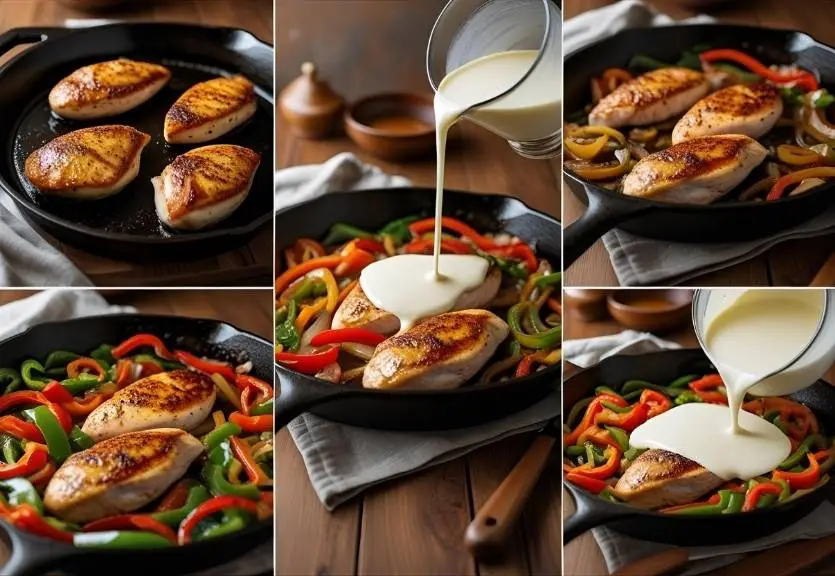
Mastering a Creamy Chicken Skillet isn’t just about tossing ingredients in a pan—it’s about technique, timing, and layering flavors carefully. Each step builds toward that perfect balance of tender chicken, vibrant vegetables, and a sauce so luscious it practically melts in your mouth. Let’s break down the process to make sure every bite is unforgettable.
How to Perfectly Sear Chicken in a Skillet
Searing chicken might sound simple, but it’s an art form that transforms texture and flavor. Start with a hot skillet—medium-high heat is key. Drizzle a small amount of olive oil and wait until it glistens; that is your signal to add the chicken to the pan. This immediate heat creates a caramelized crust that locks in moisture, giving you juicy, flavorful bites instead of dry or rubbery pieces.
Avoid crowding the pan. If the chicken pieces are too close, they’ll steam instead of sear, losing that coveted golden crust. Work in batches if needed. Season the chicken with salt and pepper right before cooking to enhance flavor without drawing out moisture prematurely.
After placing the chicken in the skillet, avoid shifting it—let it sear untouched for 4 to 5 minutes to build a golden, flavorful crust. This patience rewards you with a beautiful, deep brown color. Flip only once, cooking until the chicken is just cooked through—slightly underdone is fine, as it will finish cooking in the creamy sauce later.
Sautéing Vegetables for Maximum Flavor
After you’ve seared the chicken and set it aside, it’s time to build the dish’s foundation with vegetables. Onions and bell peppers are a classic duo here, providing sweetness and crunch that contrast beautifully with the creamy sauce.
Add the chopped onions first; their natural sugars caramelize slowly, releasing a rich, mellow flavor. Stir occasionally, but let them sit long enough to brown lightly. Then toss in the bell peppers. Their vibrant color brightens the dish, while their gentle char adds complexity.
Garlic joins the party last—since it burns quickly, it should be added once the onions and peppers have softened. Stir it in just for about 30 seconds to infuse the oil and vegetables with its fragrant, savory aroma without turning bitter.
This careful layering creates a robust flavor base, ensuring your skillet is more than just creamy—it’s bursting with depth and character.
Creating the Ultimate Creamy Sauce
Now, let’s focus on the pièce de résistance: the sauce. This step is where your Creamy Chicken Skillet truly comes to life. Once the veggies are tender and aromatic, reduce the heat to medium-low and pour in the cooking cream slowly. Keep stirring continuously to blend everything smoothly and avoid any curdling or splitting.
Add your paprika, curry powder, and seasonings here. Let the spices bloom in the cream for a minute or two, releasing their full fragrance and color. Then nestle the chicken pieces back into the skillet, spooning the sauce over them.
Let it simmer softly—just enough to thicken the sauce while keeping it rich and creamy, not overly reduced. This slow melding allows the chicken to finish cooking while soaking up the rich, spiced cream. The sauce should become silky and cling to every morsel, tying the entire dish together in a perfect harmony of flavors.
Top it off with a handful of fresh parsley to add a pop of color and a bright, fresh note that balances the richness.
3 Secrets to Making Your Creamy Chicken Skillet Irresistible
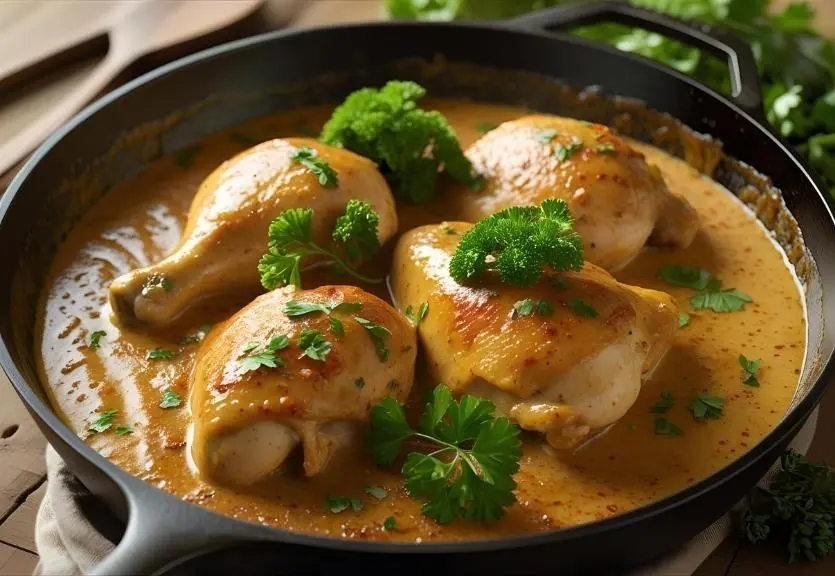
Cooking a creamy chicken skillet that stands out isn’t just about following a recipe. It’s about understanding the subtle tricks that elevate the dish from outstanding to unforgettable. These three secrets—mastering your spices, harnessing fresh herbs, and perfecting sauce consistency—unlock a world of flavor and texture that keeps everyone coming back for seconds.
Secret #1: Balancing Spices and Heat
The heart of any memorable dish lies in the dance of its spices. For this creamy chicken skillet, the challenge is to strike a perfect balance between warmth and heat—flavors that comfort and excite the palate simultaneously. Insufficient spice makes the dish bland, while excessive spice overpowers the delicate creaminess.
Begin with the warmth of paprika, which brings a subtle smokiness without burning your taste buds. Carefully sprinkle in the curry powder—its aromatic mix of turmeric, coriander, cumin, and a touch of cinnamon adds depth and warmth to each mouthful. For those who crave a little fire, a pinch of chili flakes or fresh chopped chili peppers introduces a lively kick that awakens your senses.
But the key is moderation. Add spices gradually and taste often. This mindful seasoning lets the cream mellow the heat while still allowing those bold flavors to shine through. When prepared perfectly, each bite delivers a comforting blend of soothing warmth and subtle spice.
Secret #2: Using Fresh Herbs for Freshness
Herbs are the unsung heroes that brighten creamy dishes and keep them from feeling heavy or one-dimensional. Fresh parsley is the classic choice here, but don’t hesitate to experiment with cilantro, basil, or even a touch of thyme.
Adding chopped herbs just before serving introduces a burst of color and a fresh, grassy aroma that contrasts beautifully with the richness of the sauce. The herbaceous notes cut through the creaminess, cleansing your palate and adding complexity with minimal effort.
Pro tip: gently fold herbs into the finished dish rather than cooking them extensively. This preserves their vibrant flavor and texture, giving your creamy chicken skillet a lively finish that’s as satisfying to the nose as it is to the taste buds.
Secret #3: Letting the Sauce Thicken Perfectly
The texture of your sauce can make or break a creamy skillet. Too thin, and the dish feels watery; too thick, and it becomes cloying or pasty. Achieving the ideal consistency is an art that hinges on patience and careful heat control.
After adding the cream and spices, lower the heat and let the sauce simmer slowly. This gentle cooking allows the liquid to reduce naturally, concentrating flavors while thickening just enough to cling luxuriously to each piece of chicken and vegetable.
Don’t rush this step—avoid turning up the heat in an attempt to speed things along. Instead, embrace the slow bubble, stirring occasionally to prevent sticking. You’ll know it’s ready when the sauce gently clings to the back of a spoon, showcasing a silky, velvety consistency.
This deliberate approach ensures your creamy chicken skillet isn’t just flavorful but delivers that indulgent, melt-in-your-mouth texture that makes every forkful irresistible.
Variations of the Creamy Chicken Skillet to Try Tonight
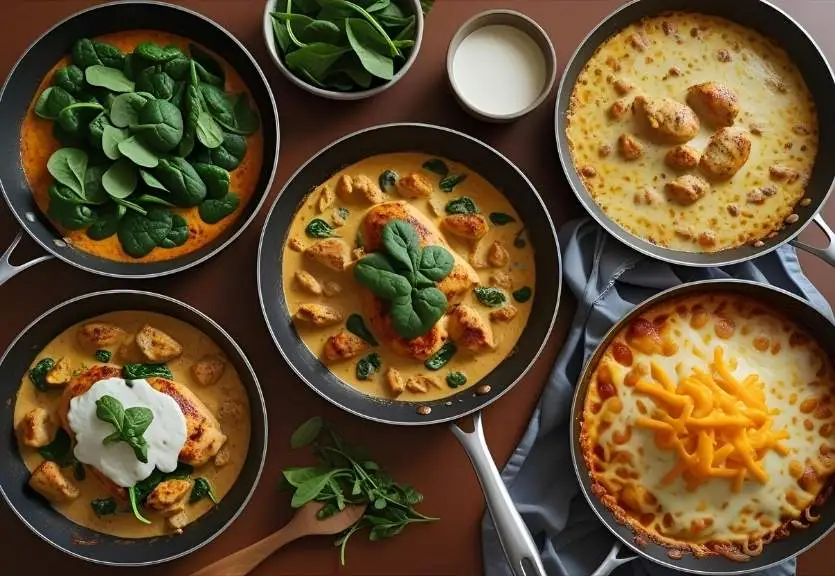
One of the best things about the Creamy Chicken Skillet is its incredible versatility. While the classic recipe is a crowd-pleaser on its own, there’s endless room to customize and experiment. Whether you want to sneak in some extra nutrition, accommodate dietary preferences, or simply jazz up the dish with extra indulgence, these variations will elevate your skillet dinner game in delightful ways.
Boosting Your Dish with Spinach or Kale for Added Greens
Greens are an easy, delicious way to add color, texture, and a boost of nutrients to your creamy chicken skillet. Tossing in fresh spinach or hearty kale not only brightens the dish visually but also balances the richness of the sauce with a fresh, slightly earthy bite.
Spinach wilts quickly and integrates seamlessly into the sauce, delivering a tender pop of green with a mild flavor that won’t overpower the spices. Kale’s firm leaves offer a robust texture and earthy charm, but lightly sautéing them beforehand helps soften their toughness.
Either way, these greens bring a vibrant freshness and a healthful twist, making your creamy chicken skillet a bit lighter but just as flavorful.
Dairy-Free Creamy Chicken Skillet Options
Craving that creamy texture but avoiding dairy? No problem. There are excellent alternatives that keep the skillet luscious without compromising taste. Full-fat coconut milk is a top contender—it offers rich creaminess and a subtle sweetness that complements the warm spices beautifully, though it does shift the flavor profile toward a tropical note.
For a less pronounced flavor change, you can try cashew cream—a blend of soaked cashews pureed into a silky, neutral-tasting cream. This option offers a thick texture and mild flavor that pairs well with savory dishes.
Both alternatives require a bit of gentle simmering to thicken properly, but they make this dish accessible for those with dairy sensitivities or vegan preferences. Just remember to adjust seasoning to taste since these substitutes behave differently from traditional cooking cream.
How to Turn It into a Cheesy Skillet Dinner
If indulgence is on your mind, why not turn your creamy chicken skillet into a cheesy extravaganza? Adding cheese elevates the dish into ultimate comfort food territory, perfect for cozy nights or special occasions.
A handful of grated Parmesan stirred into the sauce at the end adds a nutty, salty depth that complements the curry and paprika perfectly. For a gooey, melty experience, sprinkle shredded mozzarella or cheddar over the top and pop the skillet under the broiler for a few minutes until bubbly and golden.
You can also experiment with tangy feta or creamy goat cheese crumbled on top after cooking, adding layers of complexity and richness.
Cheese adds not only flavor but also a luscious texture that coats every bite, turning the skillet into a decadent, irresistible dinner.
Serving and Storing Your Creamy Chicken Skillet
You’ve just cooked up a mouthwatering Creamy Chicken Skillet, filled with tender chicken, silky sauce, and bold spices. But what next? To fully enjoy this cozy dish, it’s worth thinking about what to serve with it, how to store leftovers, and how to prep ahead for the busiest of weeks. Let’s dive into the practical side of this flavorful favorite.
Best Sides to Pair with Creamy Chicken Skillet
A rich, spiced dish like this deserves the perfect supporting cast. Luckily, there are several easy, delicious sides that balance the boldness of your creamy chicken.
- Buttery mashed potatoes are a natural pairing—soft, starchy, and perfect for soaking up every drop of that luscious sauce.
- For something lighter, try steamed jasmine rice or fluffy basmati, which bring contrast without competing for attention.
- Crusty artisan bread or homemade garlic naan can also elevate your meal. These are ideal for sopping up the leftover sauce.
- Want to go green? Roasted broccoli, lemony green beans, or even a simple arugula salad with vinaigrette can add brightness and a fresh bite.
For more ideas on serving suggestions and variations, don’t miss our detailed guide on How to Make a Flavorful Creamy Chicken Skillet, which breaks down technique and ingredient swaps step-by-step.
How to Store and Reheat Without Losing Flavor
Storing creamy dishes can be tricky, but with a few simple steps, your leftovers can taste nearly as delicious as the first time.
Let your Creamy Chicken Skillet cool to room temperature before transferring it to airtight containers. This helps prevent condensation and sogginess. Refrigerate within two hours, and aim to eat within 3–4 days for optimal freshness.
When reheating, skip the microwave if possible. Instead, gently heat it in a skillet over low to medium heat, adding a splash of water or cream to loosen the sauce as needed. This gentle method brings back the velvety consistency without breaking the cream or drying out the chicken.
If using a microwave, cover loosely and reheat in short bursts, stirring in between to avoid uneven heating.
Tips for Meal Prep with Creamy Chicken Skillet
The Creamy Chicken Skillet is a meal-prepper’s dream—it reheats beautifully and can easily be portioned out for busy weekdays.
Here’s how to do it right:
- Cook your skillet as usual, but leave out any herbs or toppings until serving.
- Divide the dish into individual airtight containers with your choice of side (rice, veggies, or pasta).
- Store in the fridge for up to 4 days or freeze for up to 2 months.
Before freezing, allow the dish to cool fully, and be certain not to overfill the container. You can also freeze the sauce separately if you plan to use freshly cooked chicken later.
Want to build a weekly meal plan around chicken skillets and creamy recipes? Websites like The Kitchn offer fantastic, budget-friendly tips and variations to help you stay organized and inspired.

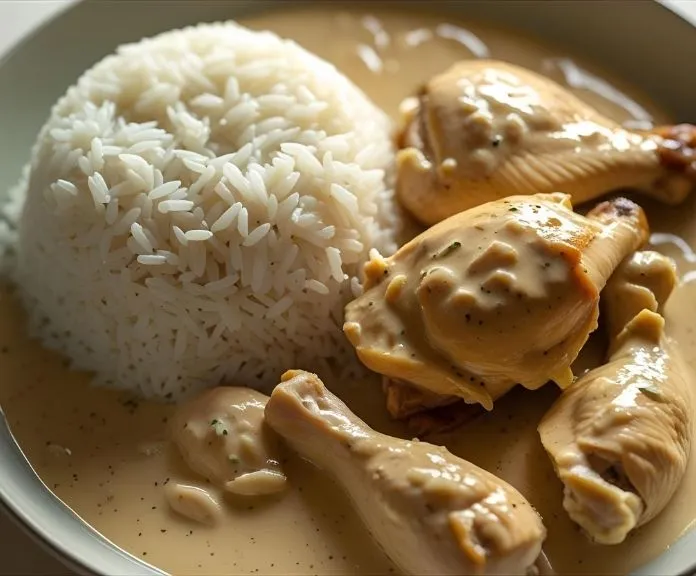

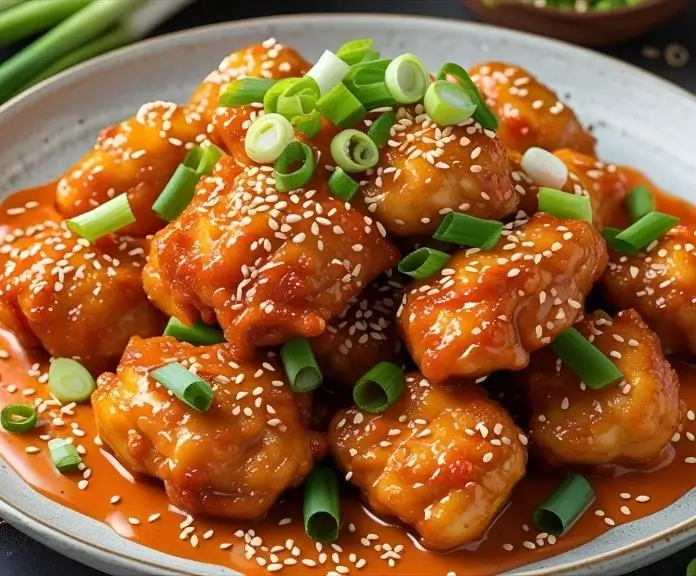
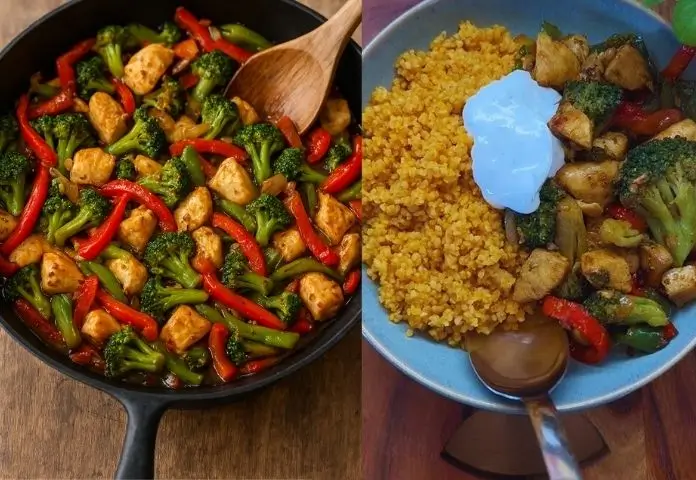
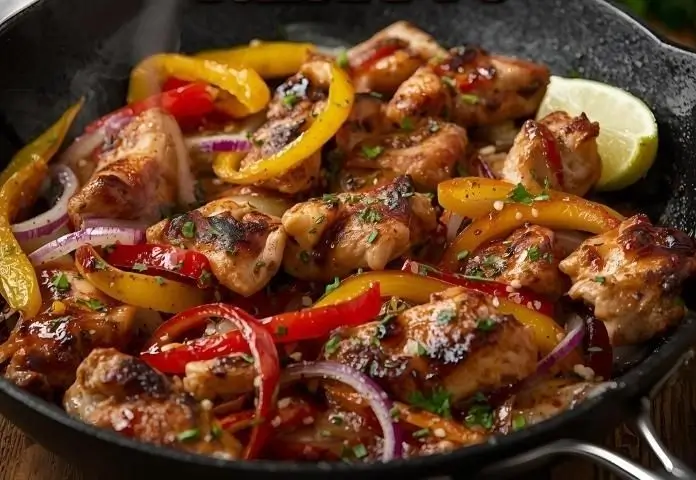
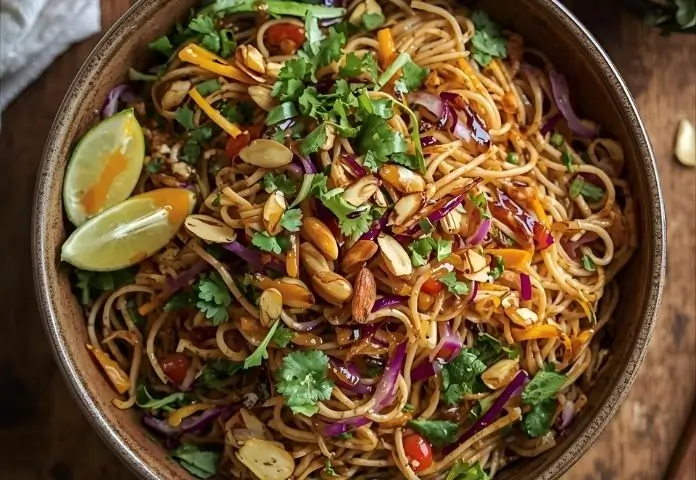

3 Comments
Comments are closed.